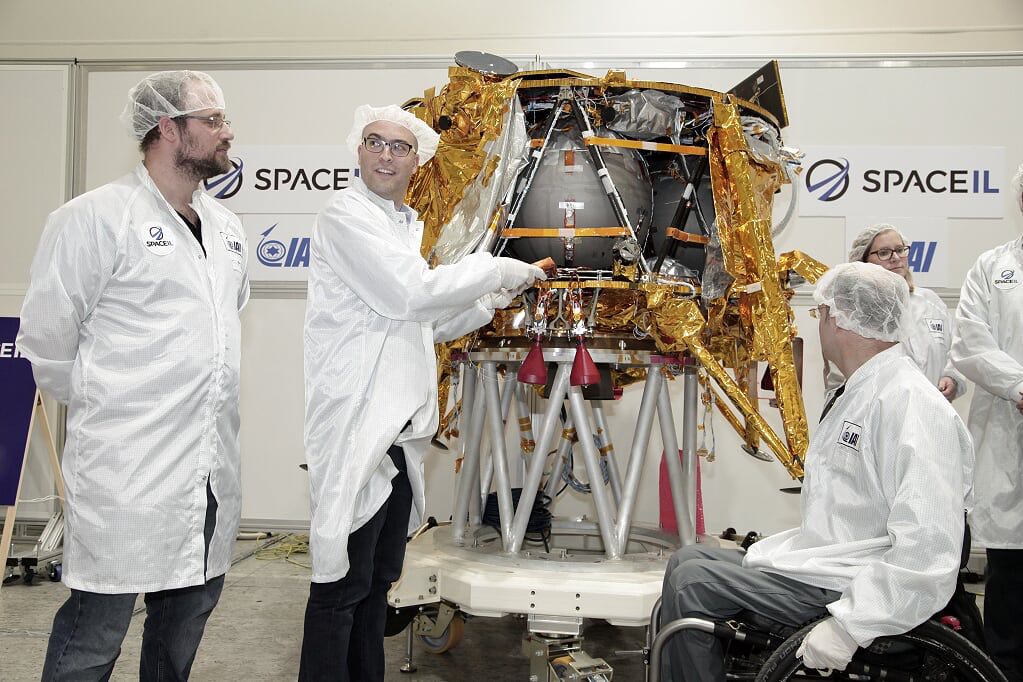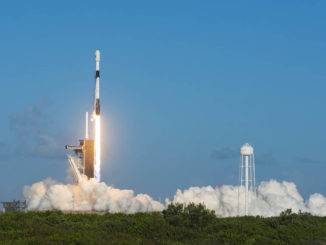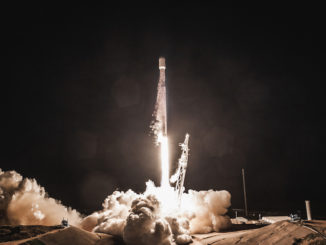
Six weeks after launching from Cape Canaveral, an Israeli-built probe funded through private donations arrived in orbit around the moon Thursday, setting the stage for the mission’s final descent to the lunar surface April 11.
Engineers at the Beresheet mission control center in Israel confirmed the successful maneuver after telemetry radioed from the spacecraft showed it fired its main engine for approximately six minutes, slowing its speed enough to allow the moon’s gravity to capture the probe in an elongated lunar orbit.
The Beresheet spacecraft ignited its main engine at 1418 GMT (10:18 a.m. EDT) Thursday for the make-or-break maneuver to steer into orbit around the moon. If the probe misfired, Israeli officials said the spacecraft would have continued on into deep space, bringing the mission to an end.
Mission controllers, managers and VIPs watched as data relayed from the spacecraft to the Israeli control center showed the engine burning normally. A display showing the total velocity change, or delta-V, from the engine firing counted upward until it reached 323.663 meters per second (724 mph).
The engine burn was designed to slow the probe’s velocity by 324 meters per second, and officials celebrated the result, which made Israel the seventh country or international organization to place a spacecraft in orbit around the moon — after Russia, the United States, Japan, the European Space Agency, China and India.
“After six weeks in space, we have succeeded in overcoming another critical stage by entering the moon’s gravity,” said Ido Anteby, CEO of SpaceIL, a non-profit organization founded in 2011 to manage Beresheet’s development. “This is another significant achievement our engineering team achieved while demonstrating determination and creativity in finding solutions to unexpected challenges. We still have a long way until the lunar landing, but I‘m convinced our team will complete the mission to land the first Israeli spacecraft on the moon, making us all proud.”
Beresheet was expected to enter an elliptical, or oval-shaped, orbit ranging between 310 miles (500 kilometers) and 6,200 miles (10,000 kilometers) above the moon’s surface. Several more engine firings during the next week will place Beresheet in a circular 124-mile-high (200-kilometer) orbit in preparation for landing.

Beresheet’s lunar capture maneuver Thursday was also historic for the commercial space industry. The mission was designed, built and launched for around $100 million, and almost all of the funding came from private donors and corporate investments.
“We’ve done it! First privately funded spacecraft in lunar orbit,” tweeted Yoav Landsman, Beresheet’s deputy mission director at SpaceIL. “Feels like the dawn of a new era of commercial space.”
Morris Kahn, a South African-born Israeli billionaire, contributed $40 million of his fortune to the project. Kahn, 89, was at Beresheet’s control center in Israel for Thursday’s critical maneuver.
“We’ve had support from all over the world,” Kahn said Thursday. “NASA has recognized what we’re doing, and the world has recognized what we’re doing, and what we’re doing is we’re pioneering something in space. We’re showing that a small country can actually do an amazing job.”
But more perils remain ahead for Beresheet. Its mission will culminate with a landing April 11 — next Thursday — in the Mare Serenitatis, or Sea of Serenity, region on the upper right part of the moon as viewed from Earth.
“After a challenging journey, we made tonight another Israeli record and became the seventh nation to orbit the moon,” said Nimrod Sheffer, CEO of Israel Aerospace Industries, Beresheet’s prime contractor. “Even before Beresheet was launched, it already was a national success story that shows our groundbreaking technological capabilities. Tonight, we again reach new heights. In the coming week, our talented engineering team will work 24/7 to bring us to an historic event on April 11.”
Beresheet launched Feb. 21 from Cape Canaveral aboard a SpaceX Falcon 9 rocket, riding piggyback with a larger Indonesian communications satellite and an experimental U.S. Air Force spacecraft.
The Falcon 9’s upper stage released Beresheet in an elliptical orbit ranging as high as 43,000 miles (69,000 kilometers) in altitude. After separation, the spacecraft deployed its four landing legs. With the lander gear extended, Beresheet has a diameter of around 7.5 feet (2.3 meters) and measures 4.9 feet (1.5 meters) tall, about the size of a golf cart.
A series of main engine burns nudged Beresheet into longer orbits that took the spacecraft farther from Earth. Beresheet traveled more than 3.4 million miles — about 5.5 million kilometers — between its departure from Cape Canaveral and arrival in lunar orbit.
Ground controllers identified an issue with the spacecraft’s star tracker cameras shortly after launch. The cameras are used to locate the positions of stars in the sky, helping determine Beresheet’s orientation in space. SpaceIL says the star trackers are too sensitive to blinding by bright sunlight.
Beresheet also missed one of its orbit-raising engine burns in late February due to a computer reset, but engineers kept mission on schedule for its arrival at the moon.

With Beresheet’s landing — the spacecraft’s most challenging task — still ahead, SpaceIL officials are still cautious about the the mission’s chances of a safe touchdown.
“Once we reach the right point we’ll be just giving the spacecraft the command to start the landing phase,” said Yariv Bash, a co-founder of SpaceIL. “From that moment on, the spacecraft will automatically start landing on its own, all the way to the surface of the moon.
“Roughly 15 feet (5 meters) or so above the surface of the moon, the velocity will go to zero, and then we’ll just shut off the motors and the spacecraft will perform a free fall all the way to the surface of the moon,” Bash said Tuesday. “The legs of the spacecraft were designed to sustain that fall, and hopefully once we are on the moon we’ll be able to send back images and videos to Earth.”
Three young Israeli engineers and entrepreneurs established SpaceIL in 2011 in pursuit of the Google Lunar X Prize, which promised $20 million grand prize for the first team to land a privately-funded spacecraft on the moon, return high-definition imagery, and demonstrate mobility on the lunar surface.
The Google Lunar X Prize contest ended last year without a winner, but Beresheet’s backers kept the mission alive.
Kahn, the mission’s largest single financial contributor, serves as SpaceIL’s president. Other donors include Miriam and Sheldon Adelson, a casino and resort magnate who lives in Las Vegas. IAI, the lander’s prime contractor, also invested some of its own internal research and development money into the program.
The Israeli Space Agency awarded SpaceIL around $2 million, the program’s only government funding.
The entire mission cost significantly less than any government-backed lunar lander. Still, raising $100 million from private donors proved a challenge.
“I never in my wildest dreams thought that we would get to something like $100 million, but once we got going, we were actually in,” Kahn said Tuesday. “It was a challenge, and actually, I love a challenge.”

The X Prize Foundation, which organized the original Google Lunar X Prize competition, announced March 28 that it will offer a $1 million “Moonshot Award” to SpaceIL if the Beresheet mission successfully lands on the moon.
“Though the Google Lunar X Prize went unclaimed, we are thrilled to have stimulated a diversity of teams from around the world to pursue their ambitious lunar missions, and we are proud to be able to recognize SpaceIL’s accomplishment with this Moonshot Award,” said Anousheh Ansari, chief executive officer of the X Prize Foundation.
“SpaceIL’s mission represents the democratization of space exploration,” said Peter Diamandis, founder and executive chairman of the X Prize Foundation. “We are optimistic about seeing this first domino fall, setting off a chain reaction of increasingly affordable and repeatable commercial missions to the moon and beyond.”
A successful landing will not only mark a first for the private space industry, but will also thrust Israel into an exclusive group of nations that have put a spacecraft on the moon. So far, the United States, Russia and China have successfully landed probes on the moon.
“We have a vision to show off Israel’s best qualities to the entire world,” said Sylvan Adams, a Canadian-Israeli businessman who helped fund the mission, in a press conference between Beresheet’s launch. “Tiny Israel, tiny, tiny Israel, is about to become the fourth nation to land on the moon. And this is a remarkable thing, because we continue to demonstrate our ability to punch far, far, far above our weight, and to show off our skills, our innovation, our creativity in tackling any difficult problem that could possibly exist.”
Because of the project’s limited budget — a fraction of the cost of government-funded lunar landers — the Israeli team had to adapt technology designed for other purposes to the moon mission. For example, the main thruster on the lander is a modified engine typically used to adjust the orbits of large communications satellites.
During the landing sequence, the engine will be switched on and off to control the lander’s descent rate. It can’t be throttled.
Most of the systems on the spacecraft were built without a backup to control costs.
“Our spacecraft has very low redundancy,” Anteby said Tuesday. “One sensor that fails could fail the whole mission.”
After landing, Beresheet will collect data on the magnetic field at the landing site. NASA also provided a laser reflector on the spacecraft, which scientists will use to determine the exact distance to the moon, and to pinpoint the lander’s location. The U.S. space agency is also providing communications and tracking support to the mission.
The German space agency — DLR — also helped the SpaceIL team with drop testing to simulate the conditions the spacecraft will encounter at the moment of landing.
The Israeli-built lander is designed to function at least two days on the moon, enough time to beam back basic scientific data and a series of panoramic images, plus a selfie. The laser reflector is a passive payload, and will be useful long after the spacecraft stops operating.
Beresheet also aims to deliver a time capsule to the moon with the Israeli flag, and digital copies of the Israeli national anthem, the Bible, and other national and cultural artifacts.
Opher Doron, general manager of IAI’s space division, said he originally did foresee any business applications for the custom-designed lander design after the Beresheet mission. But that is changing as NASA and the European Space Agency look at purchasing commercial rides to the moon for science experiments, and eventually people.
IAI and OHB, a German aerospace company, signed an agreement in January that could build on the Beresheet mission by constructing future commercial landers to ferry scientific instruments and other payloads to the moon’s surface for ESA.
According to Doron, IAI is also in discussions with U.S. companies to use Israeli technology developed for the Beresheet project on commercial lunar landers for NASA’s Commercial Lunar Payload Services program. NASA selected nine companies last year to be eligible to compete for contracts to transport science and tech demo payloads to the lunar surface.
SpaceIL and IAI were not among the winners, but Israeli engineers could partner with U.S. firms to meet NASA’s requirements.
Email the author.
Follow Stephen Clark on Twitter: @StephenClark1.



